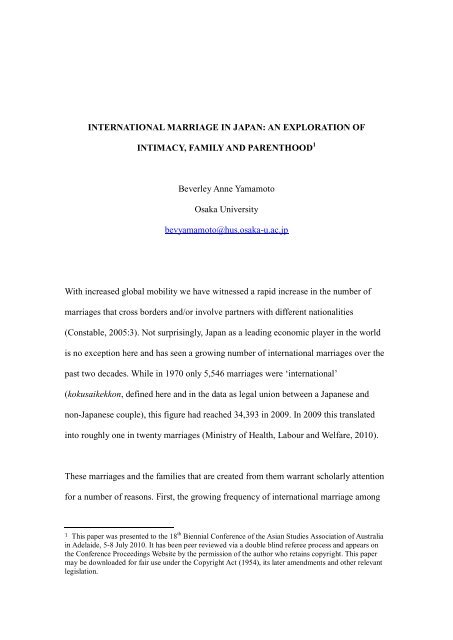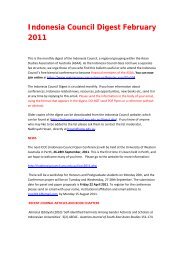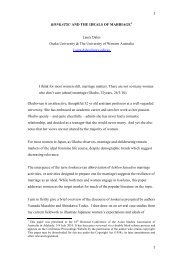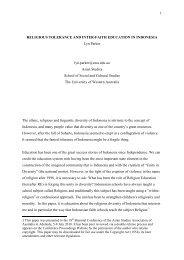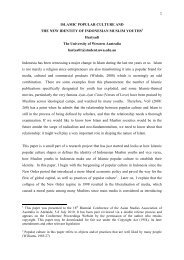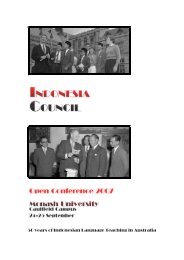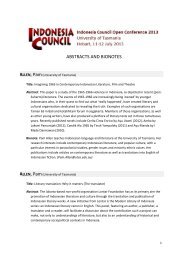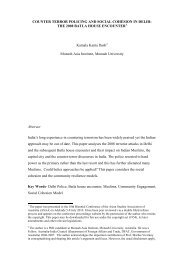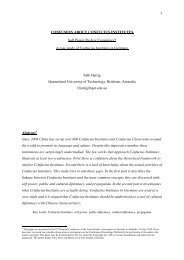INTERNATIONAL MARRIAGE IN JAPAN - Asian Studies Association ...
INTERNATIONAL MARRIAGE IN JAPAN - Asian Studies Association ...
INTERNATIONAL MARRIAGE IN JAPAN - Asian Studies Association ...
Create successful ePaper yourself
Turn your PDF publications into a flip-book with our unique Google optimized e-Paper software.
the Japanese population has taken place despite of a downward trend in marriagebetween Japanese couples. This counter-trend in itself demands a degree of sociologicalanalysis. Who is entering international marriages and on the basis of what kinds ofmotivations. How can we explain the increasing popularity of international marriage forsome Japanese when marriage between Japanese nationals has become ever lessattractive or realizable over the past two decades? Are the two interconnected? Whilethese questions have attracted a degree of scholarly attention in Japan (see for example,Suzuki, 2005, Piper, 1997, Piper and Roces, 2003, Faier, 2009, Nakamatsu, 2003), thepicture that we have remains partial and limited to certain national groups.In addition to a numerical increase, international marriage in Japan is of interest due toits highly gendered patterning; a pattern that has shifted with changing socio-economiccircumstances and regional power politics. Whereas in 1970, the majority ofinternational marriages (61%) were between a Japanese bride and a foreign(non-Japanese) groom, by 1975 the balance had reversed itself with the Japanesehusband/foreign wife union becoming the more common. This latter trend increased tothe extent that in 2009 78% of international marriages registered in Japan were betweena Japanese man and foreign woman (calculated from data available at Ministry ofHealth, Labour and Welfare, 2010). Among certain national groups, the genderedpattern is even more striking. For example, in 2009 97 percent of the 5,911 marriagesbetween Japanese and Filipinos fitted the Japanese husband/ foreign (non-Japanese)bride patterning (calculated from data available at Ministry of Health, Labour andWelfare, 2010).
migrating to Japan to marry richer Japanese men, the sending countries may embracenorms of greater gender equality than Japan, even if economically weaker. Yet, menwho marry <strong>Asian</strong> women, Japanese men included, are seen to be seeking „traditional‟wives, and „traditional‟ marriages, suggesting a incongruence in „cartographies of desire‟(Constable, 2005: 7). A primary focus in this paper is how couples embracing verydifferent gender norms and marital desires negotiate and realize their maritalrelationship.The final reason that international marriage in Japan deserves scholarly attention is thatchildren of mixed Japanese-foreign heritage have an ever growing presence in Japan.For the past decade at least, between 23 and 25 thousand children have been born eachyear to couples where one parent is Japanese and the other is foreign, although not allare necessary married (Ministry of Health, Labour and Welfare, 2008: Table 4.2 ). Thesechildren of mixed heritage are at the front line in the creation of multicultural spaces inJapan in the home, classroom and wider society. They have also been the focus ofinternational conflict, particularly in relation to custody issues when marriages break up.Nevertheless, due to their Japanese nationality they disappear from the radar in terms ofofficial interventions. Perhaps for the same reason, they have garnered little academicattention beyond a few studies on bilingualism. While it is beyond the scope of thispaper to throw a spotlight on these children of mixed heritage, we should be mindful oftheir presence when considering the topic of international marriage.
Objectives and scope of the paperThis paper has grown out of a broader panel study on educational strategies adopted bytransnational families in Japan and the impact of this on the children‟s identity or senseof self. 2 . Drawing on the first wave of a panel interview survey of couples ininternational marriages and their children living in a major metropolitan area of Japan,this paper explores the path that led to marriage and meanings both initially andsubsequently attributed to marriage, intimacy, parenthood and family by the partners.The foreign partners in these marriages are all English speaking, raised in Westerncountries and well educated. The social and educational backgrounds of the Japanesespouse are more varied. The three Japanese husbands have been educated to higherdegree level, whereas only one of the six Japanese wives completed a full universitydegree. The remaining women completed high school only (one) or two year juniorcollege (four). While pointing to the diverse patterns of lifestyle and intimacy aspired toand achieved in these marriages, this paper will also emphasize the structuring roleplayed by Japanese ideas of familial obligation and parenthood that impact strongly onall the couples‟ marital relationships regardless of initial commitments.After outlining the methodology and the interview base, I will move on to focus on thebackground to the couple meeting and getting married, the factors that led to them livein Japan, the extent to which cultural values concerning spousal relations, parenting andintimacy create or are articulated/viewed as potential areas of conflict in the relationshipand any negotiations that flow from this.2 This research has been partially funded by the Global Centre of Excellence Program, A Research Basefor Conflict <strong>Studies</strong> in the Humanities, awarded to Osaka University in 2007.
Methodology and survey sampleThe data presented here was gathered over the past two years from nine couples ininternational marriages (one or both partners were interviewed) raising children in amajor metropolitan area in Japan 3 . Couples were either interviewed together orindividually depending on their preferences and language base 4 . In total, all the wiveshave been interviewed, but to date only three of the husbands. Only couples with at leastone child in the sixth grade or above were targeted. To date, 10 out of 17 children havebeen interviewed i . Younger children will not be interviewed until they reach the sixthgrade.Contact was initially made through two junior high and high school counselors 5 in thetarget areas and, subsequently a snowballing technique was used to broaden the scope ofthe data set. One-to-two hour semi-structured interviews were carried out that coverednot only educational and parenting issues, but also the background to the couplemeeting, their decision to marry and live in Japan, the life style strategies that they haveadopted and a broad range of relationship and intimacy issues. Transcripts have beenmade of all interviews and those conducted in Japanese translated by myself intoEnglish. Any sections of Japanese that were difficult to decipher have been checked forinterpretation with a native speaker with an academic background in anthropology.3 In order to protect the identity of participants, the actual location of the study will not be given. Inaddition, pseudonyms have been used in all cases and where necessary details changed to conceal identity.As the sample is still small, I have also avoided using too personal comments or data, again to protectidentity. As the sample size increases I will use more of the data verbatim, but given the snowballingmethodology it would be too easy for participants to be able identify other couples at this stage.4 Eleven children were also interviewed, but this data will not be discussed in this paper. The childrenwere interviewed separately from their parents.5 Two international schools and one private Japanese secondary school were targeted initially.
Results and AnalysisProfile of the participantsFour of the foreign spouses are from the United States, three from the UK and one eachfrom Canada and Australia.Figure 1Nationality of foreign spouse43210American UK Australia CanadianAs shown in Figure 2, in six of the marriages it was the husband who was the foreignspouse. While this is the reverse of the overall gender patterning of internationalmarriages in Japan, it is consistent with matches between Western and Japanese couples.These are all countries by international measures of gender equality that are ranked verymuch more positively than Japan. ii
Figure 23Gender of foreignspouseWifeforeign33%6This raises a number of questions including whether the Japanese wives had or holdexpectations of „modern husbands and modern marriages‟ (Constable, 2005: 7), whilethe Western men may have sought „traditional‟ wives who in exchange for being „kept‟economically will service their needs and that of any children in the domestic sphere ina way that could perhaps not be expected of their country women. While this „clash ofdreams and expectations‟ (Hung Cam Thai, 2005:165) has been noted in the literature ofinternational marriage between <strong>Asian</strong> women and Western men (Constable, 2005:7,),how do we untangle the marriages between Japanese men and Western women? Is therea similar „clash of dreams and expectations‟ here, if so how is the marriage imagined inthe first place? These are some of the questions I would like to tease out from the databelow when looking more broadly at negotiation concerning intimacy, work, family andchild raising norms.Husbandforeign67%Path to marriageAll nine of the Japanese spouses had significant experience of living overseas rangingfrom three months to ten years prior to meeting their future spouse. Clearly overseas
experience and language proficiency will create additional opportunities for meetingand later marrying a foreign spouse. Three of the Japanese wives had gone overseas tolearn English after a brief period working following graduation from high school orjunior college (tandai). For two this experience provided the backdrop to their marriage.Another was traveling in Europe when she met her future husband. One of the Japanesehusbands met his wife overseas while studying for a high degree in the USA. Anotherhad just returned from an extensive period traveling in the USA having felt the need „toescape from Japan‟. Perhaps dating and then marrying a foreign woman helped sustainthe feeling of „escape‟ even after returning to Japan?Figure 3Where did the couplemeet?Overseas56%Japan44%There was a relatively long period of going out together or engagement beforemarriage iii . Among the respondents in this survey there was a period of between one andfive years between the couples meeting and getting married. The longer periods wereoften associated with resistance from parents on the Japanese side. One couple, who gotengaged after going out for just three months, experienced enormous resistance from the
wife‟s family here in Japan and waited for five years before finally getting the okay tomarry. The wife had not been willing to marry without her parent‟s consent.Deciding where to liveEight out of the nine couples lived together in the country of the non-Japanese spouseeither immediately before marriage and or for a period after marriage. For all of thesecouples the question of where to live, Japan, the country of the non-Japanese spouse ora third country altogether, was consciously considered and discussed. While the move toJapan was/is not necessarily seen as permanent (many envisage going back to thenon-Japanese spouse‟s country after retirement), all the couples interviewed had spentmore child raising years in Japan than outside. Three of the foreign spouses (twohusbands and one wife) came to Japan for the first time either after getting engaged ormarried. Given that staying in the country where the relationship had first blossomedmay seem the more obvious outcome, all took the decision to head to Japan withenormous implications short-term and long-term for the foreign spouse. Another couple(foreign husband FH, Japanese wife JW) came to live in Japan a little over a year aftergetting married, although the husband had been to Japan in his teenage years on aschool exchange. An revealing question is should those spouses who came to Japan as adirect result of getting engaged or married be considered „marriage migrants‟? If not,then what is different about their situation and that of Filipina women who come toJapan to marry?There were two major reasons for the couples deciding to stay in or move to Japan. Thefirst was economic. In all cases it was felt that the husbands earning power, whether
foreign or Japanese, would be higher, and along with it quality of life, if the couple livedin Japan. Thus we see a quite „traditional‟ gender logic operating here. Most married inthe late „bubble years‟ of the 1980s or in the early 1990s when economic bubble hadonly just burst and the impact was still not being felt throughout the society. For all butone of the foreign husbands, the realization of a greater earning power involvedgarnering economic value from the fact that they were native speakers of English byeither teaching it as a second language or, in the case of one, working in the field oftranslation. Only one foreign spouse was working outside the Englishteaching/translation sector.The second reason for living in Japan related to the Japanese spouses sense of familialresponsibilities. One couple (FW/JH) lived in the wife‟s country for the first five yearsof their marriage, but came back because the husband was the oldest son and expectedto run the family business. The foreign wife came to Japan for the first time when heroldest child was four. As she was a health practitioner, the move to Japan involved hergiving up her profession and she re-skilled as an English teacher. In another case(FH/JW), although the couple initially lived in the husband‟s country, the wife was anonly child and felt that she could not leave her parents alone so they moved (back) toJapan. Another couple (FH/JW) lived in the husband‟s country for nine years beforemoving to Japan to be near her parents. Whether husband or wife, the Japanese spousesheld strong feelings of filial piety that impacted greatly on their decisions about whereto settle and raise children. The Japanese spouses‟ feelings of responsibilitiesoutweighed any similar obligations that may have been felt by the foreign spouse.
Negotiating gender rolesThe couples in this survey were generally well educated, in their forties andmiddle-class by origin. Did the division of labour fall along predictable lines for thisdemographic for Japan? In other words, was the breadwinner model dominant with thehusband acting as the primary wage earner and the wife taking on the unpaid,reproductive aspects of life, including housework, child care, elderly care and engagingwith the school and local community?In order to address the above question, I indentified four patterns in the data of dividingup productive and reproductive labour and organizing the home environment (seeFigure 3). There were two versions of the „breadwinner model‟ here; one Japanese andthe other Western in orientation. The difference between the two is the positioning ofthe home and the housewife in relation to non-family members. The Japanese model hasa strong soto/uchi (inside/outside) divide where non-family members play little part.The husband and wife not only split their work roles along the typical productive/paidand reproductive/unpaid binary, but also have largely segregated social lives as well. Sothe wife socializes with her female friends and the husband is expected to findentertainment and relaxation by going out with his male friends. The wife dresses andmakes up to be with her friends and any other „outsiders‟, but wears casual wear(fudangi) and no or minimal make-up around the house. The husband also dresses downwhen in the home. The home is a place where one can relax from the necessity ofpresenting the family and oneself in a particular light to „outside world.In contrast, with the Western breadwinner model, there is the familiar productive/paid
and reproductive/unpaid division of labour along gender lines, but with a much strongeremphasis on the shared conjugal role. Husband and wife socialize together andnon-family members are invited in to the home. The home environment here is anextension of the outside of the outside world and the wife strives to look attractive bothfor her husband and any guests, and thus greater attention is paid to makeup and clothes.Figure 3I identified two additional models from the data. One is the mixed Japanese/Westernmodel where the man is the primary bread winner, but the wife also contributessubstantially to household income. The wife tends to take on duties typically marked asfeminine in both cultures, but there are some compromises here. In particular, thehusband is involved with childcare and the education of the couple‟s children. There issome degree of hosting social events, dinners and inviting in non-familiar members. Onsuch occasions, the Japanese spouse will treat the „uchi‟ environment of the home as a
quasi-soto domain and act as the host/hostess along with his/her foreign spouse.Finally, there is an egalitarian model where both partners contribute a significant degreeto household income and share most chores at home. This model leaves little time forsocializing in the context of the Japanese workplace, but where it occurs it is similar tothe mixed model mentioned above. Although I have named this a „western egalitarian‟model because of the near equal participation in productive and reproductive labour, andthe importance placed on the conjugal role, there is a degree of hybridization see, forexample, in a Japanese style of co-sleeping with children and the eating of Japanesefood.Negotiating intimacyOne area that I was particularly intrigued about was how these couple negotiatedintimacy given the wide difference in the meanings likely to be assigned to the conjugalrole. For Western, middle-class spouses public displays of affection, going out as acouple, and socializing as a couple with other couples are usually regarded as importantelements of the marital relationship. On the other hand, most middle-aged Japanesecouples, middle-class or not, would be resistant to hold hands in public let aloneshowing affection to each other in front of children. In addition, it is quite unusual forJapanese couples to socialize with other couples, unless there is a familial backdrop.Given that the couples were living in Japan, we need to ask how the respondentsorganize this area of their marriage.Socializing as a couple with other couples or single friends was much more likely in the
case of models B and C, but hardly ever occurred for the one couple in the Japanesebreadwinner model. For the two couples in Western egalitarian type relationships timewas an issue and they only occasionally socialized as a couple in this way.Going out as a couple did not happen very often and was a point of tension for some ofthe foreign husbands, who wanted time alone with their wives outside the home. Onlyone couple had consciously built this pattern into their relationship. Thus, in contrast tothe other couples Peter and Yuko prioritize couple time and generally managed to go outto the cinema or a meal together once a month when their three children were small, andmore frequently now that they are older (8, 15, 17 years). When questioned about thisPeter expressed satisfaction with the way they had managed to keep time just for thetwo of them, stating that „we have done quite well really‟ when asked how frequentlythey socialize just as a couple. Yuko was also very positive about this aspect of theirrelationship noting, when asked whether this was a positive side of internationalmarriage or not, that: „Yeah, definitely…if I was married to a Japanese man; a typicalJapanese man. I wouldn‟t have that kind of social life with my husband‟.Child raising and parenting normsChild raising is another area where the differences between the expectations of spouseswas often difficult to transverse. Homi Bhabha reminds that there are sometimesincommensurable differences between the values of people from different culturalgroups. (Bhabha, 1990:208). Ideas about how to raise children were so different forsome couple that values were almost incommensurable For example, when asked aboutchild raising issues Mike (model A type relationship) talked about the potential for
conflict in this area at great length.• BY: Are there any child raising issues between you?• Mike: Oh boy. Well, I could go on and on. Well, to make a long short storyshort,…if there are some…ahhh…conflicts between my wife and I it is here thatmy wife and I are very different… in the area of discipline, and ahhh…justcreating rules, and making the kids follow the rules...Mike then went on to talk at great length, and with extreme care for his wife‟ssensibilities as well, about the problems they had face and continue to face. Otherforeign husbands expressed some concern about their children‟s long homeworkschedules, the pressure placed on them to do well and the perception that their childrenwere not being allowed to make decisions and take responsibility as the children getolder iv . While some of this comes from the educational system in Japan, it was also feltthat their wives were erring on the side of being „educational mamas‟. Thus, whileJapanese mothers appeared to want to carefully manage their children‟s lives, especiallyin the sphere of education, the foreign fathers complained about after school, weekendand holiday study schedules.Where the mother is the foreign spouse, the Japanese husband appears less driven tointervene strongly in child raising issues regardless of cultural imperatives. When askedabout how conflicts over child raising were resolved, Kenji and Meg (Model D type)both agreed that the tendency was for Kenji to give in.Meg: I used to get my way I guess…I was at home… when the kidswere younger I was more at home and he was out working …so we
had to do it my way. And we were living in ***** and he was gettinghome quite late and it started out with me running the home as Iwanted to do it. It‟s just hard to suddenly change it. We do sharethings at home..like I said, we share household chores and stuff but Ido think as a mother.. I am probably..you know, stronger at home.Even so, the child raising norms that this couple has introduced into their home combinemany Western with Japanese elements as well, particularly regards sleepingarrangements. While Meg noted that her own mother took the view that children shouldsleep in their own rooms, in couple‟s own home in Japan they followed a Japaneseco-sleeping style until the two children were half-way though elementary school. Evennow the younger son often joins his parents at night and is reluctant to sleep alone. Thus,a kind of hybridization of child raising norms has occurred, with elements from bothcultures incorporated relatively harmoniously.ConclusionA more detailed discussion is beyond the scope of this short paper, but there are anumber of points that have been raised through this data. Firstly, this data suggests thatJapanese men and women that marry across borders were already internationallyminded before they met their future spouses. Yet, in contradiction to the „life style‟migrant discourse, all the Japanese spouses in this survey chose to return to Japan forfairly „traditional‟ reasons; to give the husband greater earning power and to fulfillperceived filial responsibilities to the Japanese partner‟s parents.
The gender dynamic in Japan appears to dictate that the woman will decide rules for thehome and child raising, whether she is Japanese or not. Both Japanese and foreignhusbands expressed views that suggested that they view the reproductive domain astheir wife‟s territory or domain. Thus, ironically the nationality of the wife, foreign orJapanese, has a major impact on the division of labour within the home. Interestingly,rather than the Japanese husbands being „traditional‟ and the Western husbands „modern‟when it comes to household chores, the reverse is the case for my respondents. At thebidding of their wives, the Japanese husbands appear ready or resigned to taking a rolein household chores even if they do not take primary responsibility. The fact that theforeign wives contribute significantly to household income and were working longhours outside the home also provided a practical dynamic for a sharing of reproductivetasks.On the other hand, the Japanese wives willingly or not (at least two women expresseddisappointment that when it came to housework their husbands seemed rather Japanese)took up much of the burden of the reproductive domain. While some contributedsignificantly to household income, this did not reduce their burden within the home.Child raising was more evenly divided up, partly because the English-speakinghusbands wanted to ensure that their children grew up bilingual. Nevertheless, theresponsibility for cleaning and cooking largely falls to the wives.Norms surrounding intimacy are a point of potential conflict, with a number of theforeign husbands expressing disappointment or frustration that they spend little timewith their wives as a couple. The husbands most satisfied in this area were the B Model
types where the wife took on the role of „modern‟ (Western), but dependent spouses.The most frustrated here was the A Model couple, who stated that they were aware andunderstood at one level the opinion or desire of the other, but at a deeper level clearlycould not.Finally, child raising norms were at one level incommensurable, especially with theJapanese mother, Western father model. The former wanted to indulge their childrenwhen young, but tighten the rules as the children got older, where the reverse was thedesire of the foreign father. This is an area that informally I have had many, longconversations with Western men married to Japanese women. The desire to produceindependent off-spring on the part of the former and the need to generate dependency bythe latter not only leads to frustration between the couple, but to difficult behavioramong the children. When the wife is the foreign spouse the dictates of Japanese cultureresult in the mother making decisions that the father is obliged to honour and thus thereis less potential for conflict. The impact of gender and intimacy norms on the children isthe subject matter of a subsequent paper.ReferencesBhabha, Homi (1990) „The Thirds Space: Interview with Homi Bhabha’ in Ders (Hg.)Identity, Community, Culture, Difference, London: Lawrence and Wishart.Constable, Nicole ed. (2005) Cross-border Marriages: Gender and Mobility inTransnational Asia, Philadelphia: University of Pennsylvania Press.Faier, Lieba (2009) Intimate Encounters: Filipina Women and the Remaking of RuralJapan, Berkeley: University of California Press.
Ministry of Health, Labour and Welfare (2010) Saikin kohyo no toukei shiryou(Statistical documentation recently made public),Retrieved at:http://www.mhlw.go.jp/toukei/saikin/hw/jinkou/suii09/marr2.html________________________________ (2009) Vital Statistics of Japan, Tokyo:Statistics and Information Department, Ministry of Health, Labour and Welfare.________________________________ (2008) Vital Statistics of Japan, Tokyo:Statistics and Information Department, Ministry of Health, Labour and Welfare.Nakamatsu, Tomoko (2003) „International Marriage through Introduction Agencies:Social and Legal Realities of “<strong>Asian</strong>” Wives of Japanese Men‟, in Piper, Nicola andRoces, Mina eds, Wife or Worker? <strong>Asian</strong> Women and Migration, Oxford: Rowman andLittlefield Publishers.Piper, Nicola (1997) „International Marriage in Japan: Race and Gender Perspectives‟,Gender Place and Culture, 4(3): 321-338.Piper, Nicola and Roces, Mina eds (2003) Wife or Worker? <strong>Asian</strong> Women and Migration,Oxford: Rowman and Littlefield Publishers.Piper, Nicola and Roces, Mina (2005) Introduction: marriage and Migration in an Ageof Globalization, in Piper, Nicola and Roces, Mina eds, Wife or Worker? <strong>Asian</strong> Womenand Migration, Oxford: Rowman and Littlefield Publishers.Sato, Michiko (2001) Farewell to Nippon: Japanese Lifestyle Migrants in Australia,Melbourne: Trans Pacific Press.United National Development Program (2010) Human Development Report 2009,Retrieved 10 th October, 2010 at:http://www.undp.org.tr/publicationsDocuments/Table_K_from_HDR_2009_EN_Gender%20Empowerment%20Measure.pdf
World Economic Forum, The (2010) The Global Gender Gap Report, 2007. Retrieved10 th October, 2010 athttp://www.weforum.org/en/initiatives/gcp/Gender%20Gap/index.htm.i Informed consent was gained from the parents and the children in order to carry outthe interviews of the children.ii The Gender Empowerment Measure (GEM), a measure of women’s agency calculatedby the United Nations Development Programme, ranked the target countries in thefollowing way for 2009: Australia 7, Canada 12, United Kingdom 15, United States 18and Japan 57 (United Nations Development Programme, 2010). Given that Japan isranked as having Very High Human Development on the basis of the HumanDevelopment Index, along with the other target countries here, the very poor rankingon GEM needs explaining. See also the Global Gender Gap Index (The WorldEconomic Forum, 2010).iii The point of reference here is data collected by two doctoral students in theinternational marriage project on Filipina-Japanese couples and women from FormerSoviet Union countries and Japanese men where the period of „dating‟ (sometimes thereare introductions) is much shorter.iv In addition to the interview data, in many informal conversations with Western menmarried to Japanese I have heard similar stories. While most men ultimately live theeducation of their children up to their wives, there was concern about the Japanese wayof raising kids.


